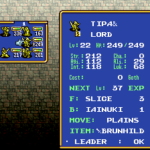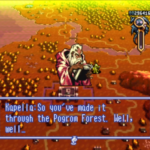I haven’t really been blogging, streaming or even talking about my progress in Ogre Battle lately. I’ve been mostly just working my way through the story.
The last time I wrote, my character was headed for the very worst of endings. Her alignment was the absolute worst. Her charisma was headed to the same point. Cities hated me. I couldn’t get the good character promotions.
I found a solution. It was obvious, really: I had to stop playing the main character, and I had to stop liberating cities and temples if there were any possibility that the enemy could retake them.
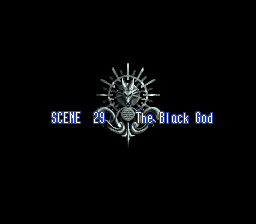
This is definitely counter-intuitive. In almost every RPG, you want your protagonist in every battle, leading every team. The problem here is that doing so in Ogre Battle commits two crimes: It levels up your protagonist such that you get an alignment hit for every kill, and you will eventually be forced to kill good-aligned enemies, like angels and such. If you want to get the best ending, you have to stay above such petty concerns.
No, the hero’s job is to stay at the rebel base until the fighting is over. When your other units have pacified the map and have surrounded the enemy base, then your protagonist’s job is to fly (yes, fly) around the map and liberate everything. Having all your units deployed without income is a hit, so get at least one payday out of it once completed before killing the boss. Your hero’s unit should at least talk to the boss before the main battle begins, but remember: Your hero’s only job is to keep their alignment and charisma at 100. They will need to fight in some battles in order to do this, so choose those battles carefully to ensure they are all higher level and preferably contain evil units like ghosts, zombies, demons and the like.
At the end of the game, my hero was level 19. Lans, who headed up my main killing unit, was level 28.
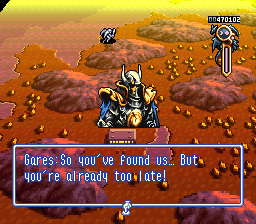
This brings up the third, and probably most important, value: the reputation. You can increase this by taking cities with a high alignment and not letting cities get retaken. This is why I (mostly) stopped taking cities. Instead, I deployed the units and just sent most of them right to the boss, keeping a token few at or near the rebel base to take care of the wanderers immediately sent out by the boss. Once you start killing the things right outside the boss city, you’ll run out of wanderers to kill. I usually used fast moving units, like my hero’s, and Canopus’, to chase down enemy wanderers, and then had DPS-focused units, like Aisha’s, to hold some likely cities.
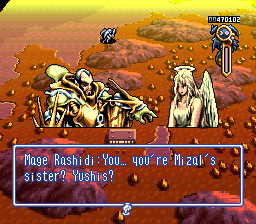
My hero’s group was:
| Tipa& | Lord |
| Dickel | Master Samurai |
| Blacks | Master Ninja |
| Omega | Wyvern |
The Master Ninja was in the back to do their HIT ALL ability. Omega was in the back for fire and to provide the group with HIGH SKY movement — the best movement power. Tipa& and Dickel were in the front for tanking and single target DPS. This group was not a killing group, but they could kill, especially with all the cards Tipa&’s group was pulling that were increasing all their attributes to the max.

Aisha’s group was perfect when I first recruited her. The only change I made was to promote her to Princess. This gave her the Starlite attack, and since she was a leader, she added one more action to all her units.
She didn’t come with a healer in her group, and I didn’t give her one, so she was what I call a “City” unit — built to destroy any enemy unit who tried to take her city. Her unit had six HIT ALL abilities, and it was very unusual for anything to walk away from that. Her unit would take damage, but being parked in a city came with natural healing and she would typically be all healed up for the next fight.
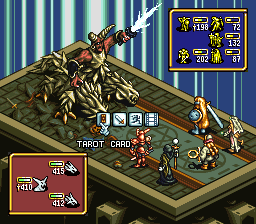
Reputation was a continual problem, and in the end I used a cheat to keep it pinned to max so I didn’t have to worry about it while I dealt with alignment and charisma and levels and all that. Left to itself, I’d be doing okay for awhile, but then I’d just find myself grinding through all the units the boss was sending out and my reputation would be down a third.
To be honest, I would have used the Game Genie to do the same thing back in the day. But the rest is legit. Keeping the hero’s unit in the rear to liberate cities and temples and do just the occasional fighting pinned the other important stats right to the top and enabled the best ending.
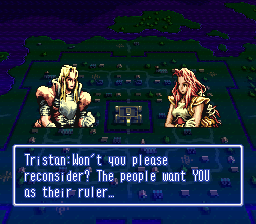
There is no way to get the best ending, I am convinced, unless you’re working from a guide. I imagine having the official strategy guide was more or less required. The manual itself tells you exactly how to approach the first half dozen levels and stresses how important are the various attributes. The official strategy guide would continue with that, I imagine. I relied heavily on GameFaqs. The official strategy guides were pricier than I wanted to pay, and GameFaqs noted that in some cases the official guide was incorrect or misleading in places.
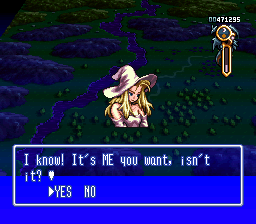
I found several sources that said that if you recruited the witch, Deneb, the pumpkin queen, you would not be able to get the best ending.
I couldn’t accept that. She’s one of the mascots for the game series, and I couldn’t believe that having her on my team could hurt me. So I spared her life on her stage, took the reputation hit, did her quest, and recruited her.
She wasn’t super effective — witches in Ogre Battle are purely support, but they do have a combo they do with the pumpkinheads they can summon. The witch stuns the enemy, making them unable to dodge the pumpkin that drops from the sky and swallows half their health. You’d then have a mage available to finish the job, otherwise you get into a Zeno’s Paradox with the health bar — always halving but never reaching zero.

The final battle is in three phases. Gares, the dark knight who made a bargain for power with the Mage Rashidi, and who has been sending clones of himself to ambush you for a couple of maps, is first. I used a lot of tarots to make him dead.
Next, Mage Rashidi, the one responsible for powering up most of the bad guys you’ve met in boss battles, comes to have a go at you. When he asks his question, “Do you want this world for yourselves so badly?” — answer YES. I answered NO and he eliminated my main and most powerful unit, Lans’, from the game. After that, it wasn’t long before my second string units ran out of power somewhere on the final boss, Diablo.
I restarted from my last save and when I came to that point, I answered YES and Lans was able to easily take him. The first time through, I ran out of tarots on the Gares and Rashidi fights and didn’t have enough for the Diablo fight. Second time through, I beat the first two bosses without tarot help and had plenty for the finale.
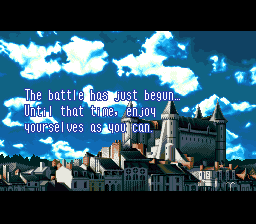
I’d spent a few hours gathering together the twelve Zodiac stones and the three magical treasures that are required for the ending, and I’d recruited all the three dragoons and those of the four devas that would agree to join me, all necessary for the best ending.
You’ll remember the Zodiac stones from the Final Fantasy Tactics series, as that series is in many ways related to the Ogre Battle series, if only because they were designed by the same person.
The events of the ending are too long to talk about here; they’re found on the web. I’ve embedded video up above for the final fights, including where I fouled up and lost a unit. Afterward, the complete final ending, epilogue, and score.

Final score: 100pt, perfect. Conquest was 141 game days, which is a little long. Other people have finished the game much more quickly. And if you don’t spend extra time slowly killing everything and liberating cities, it won’t take you long at all. You can sell buried treasure for enough to keep your armies going — I ended the game with far more money than I actually needed.
And I did it with Deneb. Ignore guides that say you need to avoid her. I did take a reputation hit. But it was probably worth it. Probably.
The manual also suggests having undead as your front line is a good move. And it is — for awhile — until the enemies start bringing clerics, shamans, paladins and monks along. And then they are suddenly worthless.
I also didn’t use many creatures. Some of them had good abilities — the cockatris Petrify ability, seeing as how it replaces the gryphon HIT ALL Gale ability, seems like a downgrade when you first get it — but its ability to just simply take units out of the fight makes it super useful. Unfortunately, having a creature in your unit almost always means not having a healer — you just don’t have room while still getting some good HIT ALL abilities, and tanking, and single target DPS.
HIT ALL abilities are really the secret sauce to winning. You don’t have to worry about healing the damage you aren’t taking, after all, so if you can just wipe out the enemy group in three turns, you’re just going to be walking away with a smile on your face.
So, in the end, Ogre Battle: The March of the Black Queen is a somewhat confusing game with a lot of stuff to keep track of, it’s meant to be played many times as you learn more and more of its secrets and work toward the best ending, and each map really doesn’t take that long once you learn the best strategy (rush the boss).
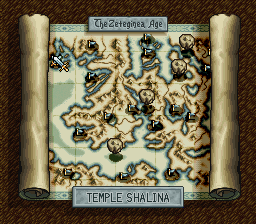
Probably its best seen as the first in a long line of tactical strategy RPGs that would change the world with its direct sequel, Tactics Ogre: Let Us Cling Together and its most famous cousin, Final Fantasy Tactics.
Both those descendants dumped the real time strategy for a turn-based chess-like battleground. Ogre Battle: Person of Lordly Caliber, a prequel to March of the Black Queen, came out a few years later for the Nintendo 64. It retains most of the Black Queen real time and unit size elements. I haven’t found this for sale yet, but I’ll keep looking.
On that note, I don’t think we ever did see a Black Queen, marching or otherwise… Unless Gares had a secret.
A frustrating at times, always complicated game that rewards bold play. Worth playing, but make sure you have a strategy guide handy.



